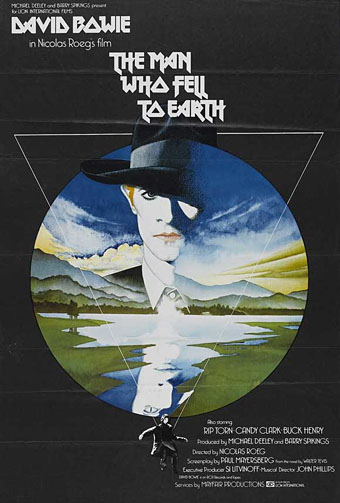
The Man Who Fell to Earth (1976).
This weekend’s viewing was The Man Who Fell to Earth on Blu-ray, highly recommended for anyone who likes the film, Anthony Richmond’s photography looks better than ever. I’ve had this for a while on DVD and what’s notable about the old and new formats is that both UK editions use Vic Fair’s poster design as the cover art. It often seems a hit-or-miss affair whether the original poster gets used for home release. This tends to happen more with older films that have acquired an artistic reputation; the recent UK release of The Conformist by Arrow Films prints four different poster designs on the inlay, with the box enclosure having a clear window that allows one or other of the designs to be facing out. A great idea which makes owning the physical copy a little more worthwhile.
I’d known the poster for Nic Roeg’s film for years but until this weekend I’d never thought to find out who was responsible for the artwork. Vic Fair was a prolific artist for UK film releases during the 1970s and 1980s so this is a small selection of his work. Apparently he was so pleased with the Roeg poster that he signed it. As is often the case with film posters, there’s no record of the designers for these examples so we don’t know who was responsible for the type layouts.
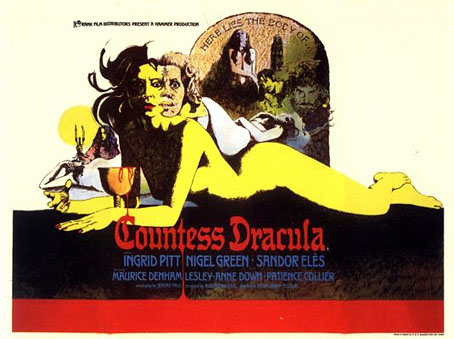
Countess Dracula (1972).
The Countess Dracula art looks surprisingly similar to some of the promotional art that Roger Dean produced around this time for UK studios, Hammer included. A few examples appear in his Views book but it’s a side of his work that’s seldom seen or discussed. I recall being impressed by the Vampire Circus poster in the past (although the big cats look a little silly). One of the better Hammers of the 70s, with a cast including cult cutie John Moulder-Brown.
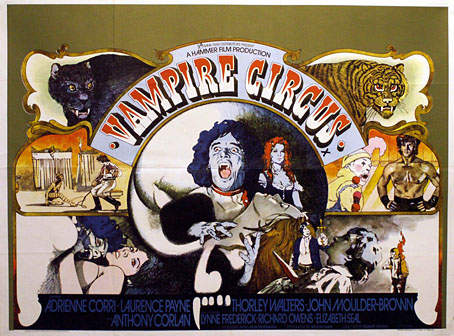
Vampire Circus (1972).
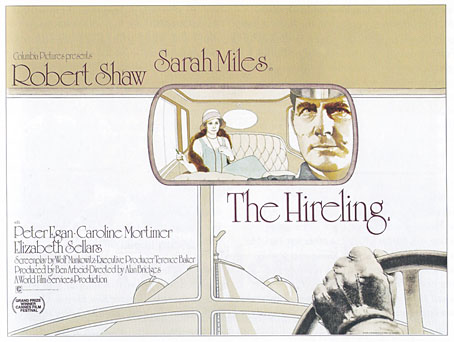
The Hireling (1973).
As with many posters of the 1970s, The Hireling is a great example of an approach that marketing departments would never allow today.
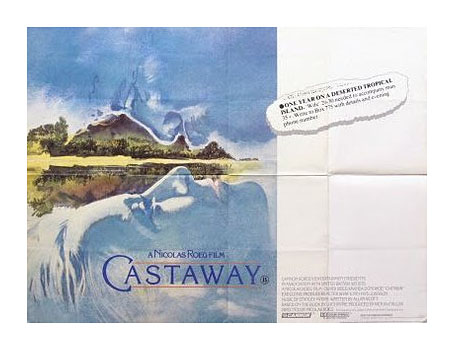
Castaway (1987).
Another Nic Roeg film, and another subtle design, possibly too subtle as I don’t recall seeing it used anywhere. First time I saw this was on the cover of a soundtrack album a few years back when I was putting together Jon Hassell’s website. There’s a piece of his music used in the film so we were trying to trace all the relevant cover art.
There’s more about Vic Fair and his contemporaries in British Film Posters: An Illustrated History by Sim Branaghan & Steve Chibnall, a book I think I ought to buy. If anything it may spare me the temptation to start collecting film posters again.
Previously on { feuilleton }
• Petulia film posters
• Lucifer Rising posters
• Wild Salomés
• Druillet’s vampires
• Bob Peak revisited
• Alice in Acidland
• Salomé posters
• Polish posters: Freedom on the Fence
• Kaleidoscope: the switched-on thriller
• The Robing of The Birds
• Franciszek Starowieyski, 1930–2009
• Dallamano’s Dorian Gray
• Czech film posters
• The poster art of Richard Amsel
• Bollywood posters
• Lussuria, Invidia, Superbia
• The poster art of Bob Peak
• A premonition of Premonition
• Metropolis posters
• Film noir posters

I really like the poster but it is not included with the American release of “The Man Who Fell to Earth.” At least, not that I can remember. I own the Criterion Collection edition which is really great as it contains a copy of Tevis’ book as well. The differences between the two really just accentuate the beauty of the other; if one hasn’t read it I really recommend it. It’s a pity he’s not more well known.
Criterion almost always design their own covers, I think. I’ve seen a couple of blogs pointing out the similarity between their MWFTE cover and the poster design for The Social Network which appeared two years later.
I’ve got two copies of Tevis’s novel. One copy was free with a magazine, the other is a film tie-in with a nice illo of Bowie on the cover, a kind of variation on the Low album profile shot. Interesting to read the book and see what Mayersberg & Roeg changed. In many ways I prefer the film, sf often works best when it’s elusive rather than spelling everything out. Unfortunately that approach is never popular with mass audiences. When the film was released in the US the distributors insisted the audience be given a sheet of notes so they knew what was going on.
This is the tie-in book cover:
http://indieethos.files.wordpress.com/2011/09/the_man_who_fell_to_earth_bowie_george_underwood_76.png
My copy is in a box so I can’t check the artist just now but it may be Peter Goodfellow. Looks like his painting style.
Great poster and also the typographic ‘inspiration’ for the Iron Maiden logo…
Never read the book myself but the film was a big inspiration for Philip K Dick in particular he used it as the basis for the fictional film being made in VALIS
http://bowiesattva.wordpress.com/2012/02/02/philip-k-dicks-valis-and-the-man-who-fell-to-earth-and-duncan-jones/
http://www.strangehorizons.com/reviews/2010/04/valis_and_later.shtml
http://www.philipkdickfans.com/literary-criticism/essays/an-afterword-to-philip-k-dicks-valis/
steve57: I was trying to find the name of the poster typeface but nobody seems to know. Lots of discussion on metal sites about how it predates the Iron Maiden logo. It was simply a new, unusual type style until the metal world claimed it. Someone on Julian Cope’s site noted there’s a Nana Mouskouri album from 1978 that uses it:
http://991.com/newGallery/Nana-Mouskouri-Nana-Live-At-The-454874.jpg
Gabe: I can see why the film would appeal to PKD, it’s still one of the best “earth viewed through alien eyes” films there is, especially at the beginning. And the end is very Dickian where he’s condemned to live as a human.
John: I’d always assumed the type was hand-rendered for the poster and lifted by Maiden… loving the Nana album cover. I’ve certainly never see the font until digital redraw appeared on Dafont etc.
Time, I think, to start scouring eBay for 1970s Letraset catalogues.
There was a proliferation of unusual type designs in the 1970s, many of them still undocumented and undigitised. I keep wishing someone would put some catalogues from the period online so questions such as this could be resolved with ease. My first introduction to typography as a specific design tool was at school when I found a Letraset catalogue in a cupboard. Discovering that all the designs had different names was a mini-revelation at the time.
I find the DEATHLINE poster concepts by Vic to be very interesting. See this snipet from a cinema annual circa 1977
http://i811.photobucket.com/albums/zz37/movieposterstudio/Roughs/DeathLine_rough_zps1a2385d7.jpg
apparently, a full quad was never released.